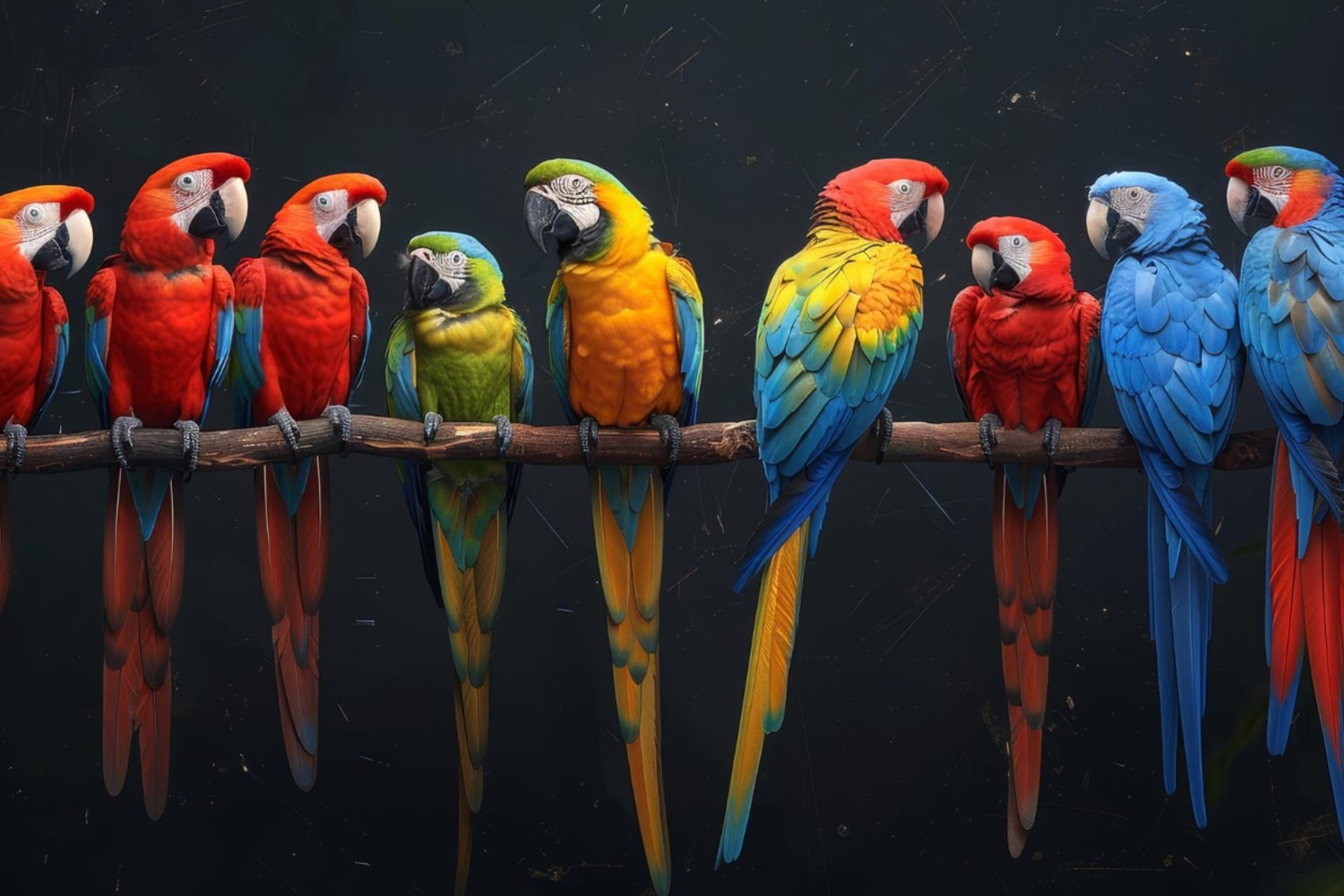Parrots are among the most intelligent and colorful birds in the world. Their vivid feathers, ability to imitate human speech, and social nature make them favorites among people on every continent. They can be found almost everywhere except in Europe and Antarctica, and their incredible diversity in size, shape, and behavior makes them one of the most fascinating creatures in the animal kingdom. Below are interesting and educational facts about parrots that you may not have known.
- There are over 400 species of parrots in the world, all belonging to the family Psittacidae. They live mainly in tropical and subtropical regions. The greatest variety of species can be found in Australia, South America, and Southeast Asia.
- The smallest parrot in the world is the pygmy parrot, native to New Guinea. It measures only about 8 centimeters in length and weighs around 10 grams. The largest species is the hyacinth macaw, which can reach one meter in length and weigh more than one and a half kilograms.
- Parrots are famous for their ability to mimic sounds, including human speech. They do not understand the meaning of words but have excellent hearing and memory, allowing them to reproduce sounds with remarkable accuracy. Some individuals can memorize up to a thousand words and phrases.
- The African grey parrot, also known as the grey parrot, is considered the best talker among parrots. It can not only repeat words but also use them in the correct context. Studies have shown that the intelligence of an African grey is comparable to that of a three-year-old child.
- A parrot’s beak has a unique structure. It is strong and curved, allowing the bird to crack nuts, peel seeds, and grasp various objects. Parrots can also use their beak as a third “leg” when climbing trees.
- Parrots have distinctive feet. Unlike most birds, they have two toes facing forward and two facing backward. This structure, called zygodactyl, helps them grip branches, hold food, and manipulate objects with ease.
- Parrots are very social creatures. In the wild, they live in flocks that can consist of dozens or even hundreds of individuals. Within the flock, they constantly communicate through sounds, body movements, and gentle beak touches.
- Most parrot species are monogamous. They form lifelong pairs and raise their chicks together. Mates groom each other, share food, and show strong affection throughout their lives.
- Some parrot species are capable of using tools. For example, palm cockatoos use sticks or stones to extract seeds from fruits. This demonstrates a high level of intelligence and problem-solving ability.
- The lifespan of parrots varies greatly depending on the species. Small budgerigars live about 10 to 15 years, while larger macaws and cockatoos can live up to 60 or even 80 years. Some pet parrots have been known to live for over 100 years.
- Parrots have excellent vision and can see not only visible colors but also ultraviolet light. This helps them identify ripe fruits, navigate dense forests, and recognize one another.
- Their diet depends on their species and habitat. In the wild, parrots eat fruits, seeds, nuts, flowers, and sometimes insects. A varied diet helps them maintain their bright and vibrant feather colors.
- The vivid colors of a parrot’s feathers are created not only by pigments but also by the microscopic structure of the feathers themselves. These structures reflect light in different ways, producing a shimmering effect. This is why parrots appear even more radiant in sunlight.
- Parrots play an important ecological role in spreading seeds. By eating fruits and dispersing the seeds over wide distances, they contribute to the regeneration of tropical forests. In this way, they help maintain the balance of nature.
- Parrots are emotional and have excellent memories. They recognize their owners, remember faces, and may become sad or stressed when left alone. Many owners notice that parrots can sense and react to human moods.
- Australia is home to a unique species called the kakapo, or owl parrot. It is the only flightless parrot in the world and is nocturnal by nature. Unfortunately, the kakapo is critically endangered, with fewer than two hundred individuals remaining today.
- Parrots are incredibly clever and resourceful birds. There are documented cases of parrots opening their cages from the inside or solving simple puzzles. Their brains have a high density of neurons, making them some of the smartest birds on Earth.
- In ancient times, parrots were considered symbols of joy, sunlight, and friendship. They appeared in temple art and jewelry in India, Peru, and Egypt. In many cultures, the parrot represented the connection between humans and nature.
- Parrots can imitate not only human speech but also a variety of sounds — such as telephone rings, dog barking, or even household noises. Their flexible tongues and complex vocal organs enable them to reproduce sounds with remarkable accuracy.
- Some parrots, particularly cockatoos, can dance to the rhythm of music. Scientists have confirmed that these movements are not random but show a genuine sense of rhythm. These birds can synchronize their movements to melodies, demonstrating impressive cognitive skills.
Parrots are a true marvel of nature. They captivate us with their intelligence, beauty, and ability to form emotional bonds with humans. These fascinating facts reveal just how extraordinary these birds are — bringing color, joy, and harmony into our lives.





